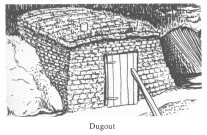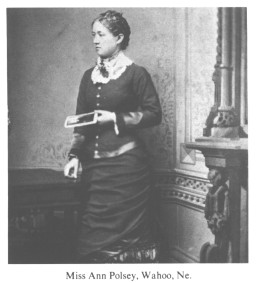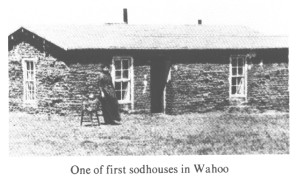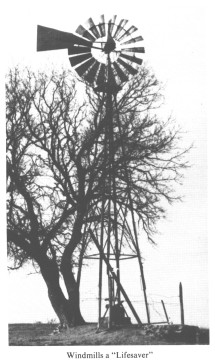Part 3
PIONEERS AND HOMESTEADERS
Prior to the 1850's, many people had passed through this area crossing the Platte at Saline Ford. But none came to settle. President Franklin Pierce signed the Kansas-Nebraska Bill on May 30, 1854, throwing open the territories for settlement.
The first white settler within the territory called Saunders County was Joseph Stambaugh. He came looking for a home but he did not stay, but he returned to Ashland the next year on March 30, 1857, with his wife, three small children and his hired man, John Aughe. He found that Reuben Warbritton had staked a claim near Saline Ford (Ashland) and Harrison Ramsey had settled about one mile north. He paid a nominal price for his land and he, Warbritton and Aughe broke the first ground to construct sod dugouts for their homes. The dimensions of Stambaugh's house were 17 X 17 feet.
page 10
An early account records that the Indians were "thick as grasshoppers" and were a constant source of trouble to the Stambaugh family. Their first home was destroyed by the Indians and they were compelled to seek protection with friends in Cass County. They returned to build another home and their son, John, was the second white child born in the county on April 9, 1858. The first was a son of Harrison Ramsey and wife in March, 1858, about one mile north of Ashland on the south side of Wahoo Creek.
Annabelle Lee was the first white child born in Wahoo on May 29, 1872. She was the eldest daughter of James and Sarah Lee. James Lee was credited with being the founder of Wahoo.
The first marriage license issued in the county was granted by Andrew Marble, probate judge, on November 7, 1856, to Mr. Samuel V. Bumgarden and Miss Lucinda Hooker, all of Saunders County.
A great epidemic of malaria swept the nation and reached the county in 1857.
The death of a Mr. Aldrich in the late summer of 1861 was the first in Saunders County. He suffocated in a well on the farm of Perry Tarpenning. The funeral was July 20, 1861. There were no undertakers at that time, the neighbors simply hewed a casket out of native lumber.
A vivid picture of the black-headed grasshopper scourge in 1874 was given by the late Mrs. Van Driel of Malmo. "I had gone to the garden after sweet corn for dinner and was returning with an armful when I noticed a darkening in the sky. Suddenly, I realized I was covered by a crawling crunching mass of insects. So voracious were they that nothing but the bare cobs remained when I reached the house."
Ownership of a team and wagon gave a man a certain standing in the frontier community. There were ice-cream socials and church services (Roman Catholics and "hard-shell Baptists" worshipped together.)
 |
| Dugout |
Life on the prairie homestead could be quite a dismal existence, especially for women. This could be characterized as "wash day blues." Often short of homemade lye-and-ashes soap, she would scrub her clothes in creek water until, she said, they were "clean for brown but awfully dirty for white."
Most settlers used a cast-iron Franklin stove for cooking as well as heating, with a sheet-iron pipe rigged through the roof for a chimney. In a country so short of firewood, their stoves were designed so they could burn hay, dried corn cobs and sun flower stalks. Also, they used cow chips, the domesticated version of the buffalo dung of the covered wagon pioneers. Cow chips were not easy to use. They burned very quickly.
A youngster who watched his mother baking told: "Stoke the stove, get out the flour sack, stoke the stove, wash your hands, mix the biscuits with the top of the baking powder can, stoke the stove, wash your hands, put the pan of biscuits in the oven, keep on stoking the stove until the biscuits are done." Needless to say, the next step would be for the cook to wash her hands again and serve dinner, even if she were too "tuckered" out to eat.
Excerpts from two pioneer stories from a diary kept by William D. McCord and submitted by his granddaughter, Mrs. Irene McClay, formerly of Mead, and one by Mary A. Porter, formerly of the Malmo area follow.
William D. McCord was born February 16, 1831 in Lawrance County, Pa. He served in the Civil War. Afterwards, he returned to Illinois and was married to Mary Elizabeth Clegg in Woodford County on February 6, 1865.
At this time, Veterans and anyone else interested were urged to "Go West" and settle on new land. On September 8, 1869, he left Minonk, Illinois in a covered wagon going across Iowa into Nebraska looking for land to settle on. He crossed the Missouri River near Nebraska City on a ferry. He made several camping and land scouting stops along the Nemaha rivers before going into Saunders County.
He liked the looks of Nebraska very much. He returned to Illinois in October and 16 months later brought his wife and four small children with him to Nebraska. They arrived by train at Omaha February 10, and March 1 crossed the Platte River on ferry at Valley Crossing.
Diary states they arrived in Saunders County March 7 and March 18 moved into their home. May 8 commenced breaking prairie and the next day planted some corn. The next two years he records planting apple trees, cutting and stacking Golden Drop Wheat and cutting and stacking flax.
The first fall he mentions burning corn for fuel. Later notes mention going for loads of wood; most of it had to be hauled from Fremont or other spots near the river because there were few trees anywhere else.
Bands of Indians still went through the county stopping to beg for food (in some cases stealing it from the settlers). His wife was deathly afraid of them at first and would send the children upstairs to hide, then prop a table or chair or whatever was handy against door. Gradually she became used to them and would give them something to eat if she had it to spare.
Life wasn't easy for the pioneers. It took courage and perseverance to keep going. Drouth and grasshoppers were only a part of their trials. Sickness and unavailability of doctors and medicine made things much harder.
His wife died in 1879 - 8 years after coming to Nebraska, leaving a family of six children: James, Charles, William, Mary (May), Etta (Alfaretta) and Clara. The oldest girl, Mary, was nine and Clara 13 years of age.
The girls stayed with relatives until Mary was 14 when she, with the other girls, came home to "keep house" for father and brothers. Prior to this he and boys "batched."
Grandpa said Mary should come home when she learned to bake bread and Aunt Louise McCord, with whom she went to live, said "I saw to it she didn't learn before she was 14. That's plenty young to keep house for a family of seven." Diphtheria, a dreaded disease at this time, took the life of Clara when she was 12.
W.D. McCord took an active part in county and community affairs. He helped organize the Marietta Presbyterian Church in the Adams schoolhouse in 1871. Again he helped build it when it was destroyed by a violent storm on June 25, 1882.
MARY ANN SHORT PORTER
Mrs. Mary A. Porter Helped to Fight Prairie Fires
Near Present Site of Malmo
Mrs. Mary Ann Porter
Copied from newspaper about 1923
Mrs. Mary A. Porter of Wahoo, was born in Pennsylvania in 1854. Her parents, Mr. and Mrs. Jacob Short moved to Royal Center, Indiana, a year or two later, where they lived until the spring of 1870 when they came to Nebraska, arriving at Elkhorn where they had some relatives and friends, May 27, 1870. Her parents soon after took up a homestead on Sec. 10 in Mariposa Precinct, the farm now owned by Otto Schulz, just north of Malmo. Their near neighbors were the M.S. Hills and George Huddle families. One of the first houses of the Hills family was made of boards nailed up perpendicularly and the cracks battened on the outside. As fast as they got newspapers, they read one side of them and then pasted them on the inside of the house over the cracks to further help keep out the wind. This kind of wall paper however had its advantages because when the settler got hungry for reading matter he could go over to the wall and help himself to it from the interior decorations.
Mrs. Porter also recalls that when Mr. Hills was away working on the railroad as nearly all of those old settlers did more or less for that was one of the best sources of ready money, one of the Short girls used to stay with Mrs. Hills and they quite frequently had some very exciting experiences.
One of these happened when Mrs. Porter, then Mary Short, was at the Hills place and a great prairie fire swept over the country around them. The Shorts and Hills however had broken out what was called a "backfire" in those days or a ring of plowed ground a couple of rods wide around the house and barn to protect them against uncontrollable prairie fires.
Mrs. Porter was approximately 10 years old when she came to the county and old enough to share in the hardships incident to the building of a new country. She knows all about the grasshoppers, drought, panics, hard times, the Green Backers (The Pops), the begging and thieving Indians, the old settlers, who used to swipe bridge material because they thought they needed it worse than the county did, which was probably true, the old steam wagon which started to make a trip to California from Nebraska City, but broke down just south of Lincoln and stayed right there until it rotted, how near the State Capitol came being located at Neapolis, 3 miles northeast of Cedar Bluffs on either the Krause or Kreisel farms, but on account of a political row was located on Salt Creek down in Lancaster and Neapolis became a corn field instead of the Capital of Nebraska, and the removal of the County Seat from Ashland to Wahoo, and Coxey's army, for all of these subjects were current topics of discussion some time during her fifty years residence in Saunders County. When she came to the county there was no Wahoo, only Lee's store and Charley Star's blacksmith shop, and no railroads. All supplies for Lee's store were hauled from Fremont, Ashland or Lincoln. A stage line operated between Fremont and Lincoln. What wheat and corn they had to sell went to Fremont and had to be ferried across the river. Another story by Mary Ann Porter Broome
 |
| Miss Ann Polsey, Wahoo, Ne. |
PIONEER EXPERIENCES
"Mr. Meduna remembers seeing cowboys herding cattle by the thousands. His father's farm was near Valparaiso and only 2 sod houses could be seen at a distance of 9 miles. As late as 1881 much land to the south was unsettled. The Overland Trail was only a quarter of a mile from his farm.
A friend of his, George Hejtman, had walked to Wyoming from Omaha to work for U.P.R.R. He wore out two pairs of shoes before he got back to Saunders Co. in 1868. He married Anna Karlik and homesteaded 5 miles northwest of Weston. Their home was a dugout covered with slough grass. Their only possessions a few chickens - a gift from a friend. He bought a cow in Omaha, which he had to drive to his home by way of Fremont, waiting several days for a ferry to take him across the Platte River." From excerpts of Pioneer experiences told to Frank Meduna
Page 11
HENRY KUHR
This is a story about my grandfather, Henry Kuhr, as told to a Wahoo newspaper in September, 1933.
Prominent among the pioneers of Saunders County is Henry Kuhr of Union Precinct. Mr. Kuhr's experiences have indeed been many and varied, reading more like a book than the ordinary fruitful life of an early settler. Coming to this county from the northern part of Germany in 1870, Mr. Kuhr made his home in this county ever since, excepting the first year which was spent in Omaha. He will be 82 years of age on October 3rd of this year and came to this country in 1870.
Some years before coming to America Mr. Kuhr undertook a trip to England. Throughout the entire passage, the vessel was beset by violent storms. Such weather was not very encouraging to a young man on his first voyage. Mr. Kuhr says "After the trip I agreed with a sailor who told me that young men never became sailors after they had gone sailing in a storm." However, the adventure did not keep him from later making the longer trip into this country, where he was to become a highly respected citizen.
The first land bought in this country by Mr. Kuhr is still owned by him, and is the south 80 acres of his 340 acre farm. He lived on this land until 1893 when he bought more land at $42.50 an acre, built and moved into the house in which he lives today. Depressions are nothing new to Henry Kuhr. He has witnessed prosperity and depression so many times in the past 63 years that he was able to predict the coming of the last session of hard times.
At one time before the war, Banker Shoemaker of Mead offered Kuhr $325 an acre for his land. Just four years later a four hundred acre farm of similar land was sold for $132.50 an acre. Hard times are always reflected in land prices according to Mr. Kuhr. "In the early days", he says, "All settlers were poor, but they worked hard and were happy! - much happier than people today."
A family of ten children, four boys and six girls, have helped to make life interesting for Mr. Kuhr. They are: Tena, Anna, Margaret, Emma, Henry, John, Herman, Rose, George, and Lena. All of them are alive and well today, and 9 of them still reside in Saunders County. The tenth, a daughter resides in Thurston County, near Pender. Their father has helped them all to become established and as he says, "I have to keep a little for myself."
In 1873, Mr. Kuhr's parents followed to this country and settled near Yutan. They bought 80 acres of land, 11 sows, and 73 pigs and farm machinery from a soldier, who had acquired the land from the government after the Civil War. Each soldier was given 160 acres of land. Kuhr's parents bought from a soldier named Riley who had taken 80 acres in Kansas. It is very probable that he found the distance between his farms a little too much of a handicap when it came to farming them both. The usual procedure in the case of such land was that the occupant had to wait five years before receiving a deed from the government. However, the elder Kuhrs received a deed in only three years.
One noteworthy incident was the grasshopper plague in 1874. According to Mr. Kuhr those grasshoppers ate only the silk from the ears of corn. As a result, no corn would develop upon an otherwise healthy stalk. The depression hoppers of 1932 had much more hearty appetites.
Not all of Henry Kuhr's years have been spent a farmer, however. It was as a railroader on the Union Pacific section at Sidney that he came to know of the hardships of early life on the Nebraska prairies. He was amused to relate one Indian scare given the railroad men. "We were coming in from work on the hand car when we were stopped by a big Indian with an old brass-plated Winchester rifle. We had a rifle too, so we had no trouble. But when we got to the depot at Ogallala, the place was full of Indians, men, women, and children. There was a big meal for us in the cook house, but with all the windows full of Indians, watching the progress of the meal, no one felt like eating much. The Indians seemed friendly enough, but no one would have liked to be out alone with them."
"Another time," he said, "a man named Tom Brown, an Irishman, was walking out to camp seven miles from Sidney when he ran across an Indian camp. He was scared but decided it was better to walk right into camp. The Indians were friendly, and since it was a cold night he stayed all night in the chief's wigwam. The wigwam was made of buffalo hides and the floor was covered with them. There was a fire in the middle that kept the place pretty warm. It was so cold those days that we had to push the hand car out to work and back to keep from freezing, yet when I went back with Brown to the Indian camp the next day to take the old chief some tobacco, the chief just had a blanket draped over his shoulders to keep him warm. A white man dressed like that would have frozen in fifteen minutes."
Mr. Kuhr is convinced that the Indian originally came from China, and knows of one tribe that could understand the Chinese lingo. He believes that the Indian was often used harshly by the white man, and that he was justified in resisting the efforts of the whites to take his country. Mr. Kuhr says: "Buffalo and antelope were plentiful at that time, but the Indians would kill only what they needed for food while white people would kill all they could for sport and then leave them lay."
Mr. Kuhr is keenly interested in world affairs as they are today, believing that foreign countries live a little better than the United States because the kings control the people better than does our government. He is a little doubtful as to whether President Roosevelt's present policies will work out for the best and believes that a stabilized currency should be established.
Grandpa Kuhr passed away in December of 1933. There are two of his daughters who are still living: my mother, Mrs. Rose Eggers of rural Fremont and Lena Kuhr, who is living in Yutan. Submitted by Mary Ann Cernin
SOD HOUSES IN SAUNDERS COUNTY
Sod houses are generally associated with only the western part of Nebraska. Many of the first settlers in Saunders County built sod houses even when near streams, where logs were available. The sod house was easier to heat in winter and was comfortably cool in summer. These sod homes were replaced by log or frame buildings as soon as the settler found the time and the necessary money to build a better home.
 |
| One of first sodhouses in Wahoo |
The breaking plow turned up the tough sod, which made the thick walls for the sod home. Poles and brush and long grass made the roof, which was also covered with sod. The floor in most cases was simply made of tamped earth.
The plow used to cut sod for the soddies was called a grasshopper plow. Oxen were used to pull it because they walked very straight, producing a uniform strip of sod.
Later the floors were covered with boards. The walls were plastered of a mixture of clay and ashes and white-washed. Those who could afford it, put a board and tar cover over the sod roof. Sometimes a sheet of canvas was attached under the ceiling. This concealed the rough poles and brush. It would keep dirt, sticks and insects from falling into the beds, stove and table. Doors were homemade and the simple windows had many panes so only parts would break.
Some dug-outs in a hill or bank were also built. Here, only one side and the roof had to be supplied with sod. The main part was dug out of the bank. These sometimes lacked a window; otherwise, they were finished like the sod houses. Submitted by Frank T. Tesar
WINDMILLS
Windmills became a great life saver to the pioneers in the 1860's. They learned to harness the wind's energy to pump their precious water. Railroads used them to pump their water, too. The prairie land soon came fairly alive with them. One man boasted he could spot "30 or more of them when he climbed to oil his wheel."
 |
| Windmills a "Lifesaver" |
The blades in the first fan wheels were wood. These were "Halladay's Standard" wooden wheels. Later came the metal ones. Soon the metal was galvanized. "Aermotor" seemed to be most popular in Saunders County.
David Roberts was credited with bringing the first windmill into Saunders County from Lincoln to J.D. Cook's farm.
There was a Wahoo town windmill located at the intersection of 5th and Broadway in the exact center of the street for the town's water supply. It was dismantled in 1876 "after years of service."
POPULATION
The first U.S. Census that recorded residents in Saunders County was in 1870. In 1860, the Census Bureau did not believe the number of people living in the county was worth the postage to send back to Washington.
Population 1979: Ashland 2,176; Cedar Bluffs 616; Ceresco 474; Colon 109; Malmo 131; Mead 488; Morse Bluff 162; Memphis 71; Leshara 102; Ithaca 121; Swedeburg (unincorporated); Yutan 507; Valparaiso 415; Wahoo 3,835.
The 1980 population census of the Co. is estimated at 18,750.
In 1983, there are about 2,500 farms in the county.
Page 12
| 



